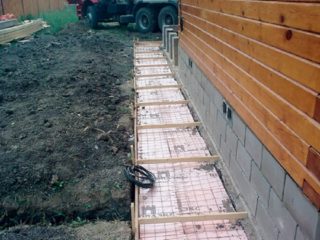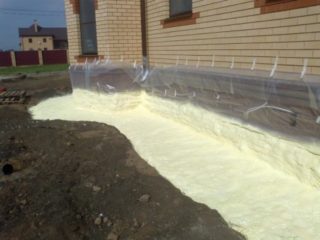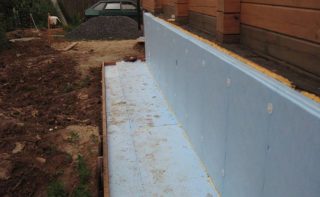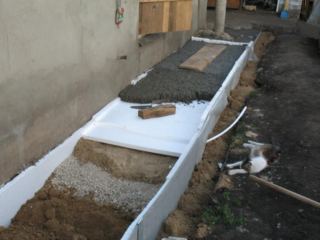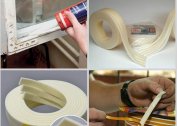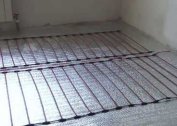Ideal conditions for living in a private house are normal humidity and the absence of temperature changes. If one of these factors deviates from optimal indicators, dampness appears on the premises of the first floor, walking on cold floors becomes unpleasant and dangerous to health. A comfortable microclimate is achieved by conducting a comprehensive thermal insulation of the building. An integral part of this process is the insulation of the foundation and the blind area. The correct choice of materials and compliance with the technology of their installation will achieve the desired result and extend the life of the building. This work is not particularly difficult, it can be easily done with your own hands.
The need for insulation of the blind areas
It is necessary to conduct insulation of the blind areas for the following reasons:
- In cold winters, the soil freezes deep enough to completely cool the foundation and basement. The result of this phenomenon is increased heat loss and increased energy costs for high-quality heating of the building.
- Warm blind area well retains the heat that accumulates in the ground during the warm season. As a result, it takes much longer for the soil around the house to cool, and the cold to get to its base.
- Frozen soil during freezing significantly increases in volume. This leads to the fact that already a few years after the construction of the basement walls and strip foundations begin to crack and squeeze out. As a result, emergencies arise that cannot always be eliminated even by overhaul.
- The insulated blind area in winter retains heat, and in the summer cool in the underground part of the building. Due to this, the concrete remains stable. There is no likelihood of developing fungus and mold on it.
- Savings at the initial stage of construction. There is no need to make a deeply buried foundation, since the thermal insulation layer will reduce the level of soil freezing by 1.5-2 times.
The conclusion is obvious - it is necessary to insulate the blind area. It is advisable to do this even at the stage of building construction in order to initially eliminate the negative impact on its foundation.
The choice of material for insulation
In many ways, the quality of insulation is determined by the characteristics of the facing coating. Most often it is made of asphalt, pavers, concrete, paving slabs or artificial stone. It is advisable to choose materials that are leakproof and insulating.
The following requirements are made to a heater:
- lack of hydrophobicity, ability to resist moisture;
- biological inertness against insects and microorganisms;
- resistance to alkalis and acids that are present in the soil;
- volume and shape stability;
- long service life;
- strong enough to withstand the pressure of the earth.
These characteristics are far from all materials.
Extruded Styrofoam
Extruded polystyrene foam (foam) is made on an extruder through which a foamed polymer mixture is passed under pressure. Finished products are plates of various shapes and thicknesses. A distinctive feature of the products are the edges in the form of a step.Thanks to this solution, a seamless surface is obtained, characterized by excellent insulating qualities.
In addition, the material has the following advantages:
- water tightness;
- elasticity and slight flexibility;
- low density;
- low thermal conductivity;
- resistance to chemically active environment;
- ease;
- simplicity and high speed of installation;
- immunity to temperature extremes;
- long service life of at least 50 years;
- environmental Safety.
Insulation of the foundation and blind areas of the house from the outside with polystyrene foam can be performed in any type of soil, including excessively wet.
Penoizol
Penoizol is an effective tool that can be applied on smooth and complex surfaces. Liquid under pressure adheres tightly to all substances, after foaming it fills all voids. The result is a monolithic layer of dense substance in consistency resembling foam.
Advantages of penoizol:
- biological resistance;
- the highest application rate among analogues;
- excellent adhesion to any materials;
- resistance to temperature extremes;
- does not decompose;
- lack of need for preparatory and finishing work.
The disadvantage of the material is its price. Warming is carried out with household aerosol cans or with the help of industrial equipment. Both are quite expensive.
Styrofoam
Polyfoam is a heater tested over the years, which has found wide application in private construction. One of its advantages is the affordable price for all categories of the population, which allows the use of expanded polystyrene on a large scale. Available in the form of square meter plates with a thickness of 50 mm, 100 mm, 150 mm and 200 mm.
In addition, the material has the following advantages:
- ease;
- low thermal conductivity;
- ease of installation;
- durability;
- water resistance;
- ecological cleanliness.
The disadvantage of foam is its fragility. Plates crumble and break due to shock and pressure. When working with them, care must be taken.
Expanded clay
Expanded clay is the result of vulcanization of a substance based on natural clay. The finished product is a rounded porous balls. It goes on sale in bulk or packaged in bags. The material has an affordable cost, which is why it is popular with private developers.
The insulation has the following advantages:
- the convenience of use;
- low thermal conductivity;
- environmental Safety;
- biological inertness.
Expanded clay has its drawbacks. Over time, the granules decrease in size, which leads to the formation of voids. In addition, expanded clay has a high hygroscopicity, absorbs water well, as a result of which its performance is deteriorating.
Step-by-step instructions for warming the blind area
The construction of the foundation of the house should be carried out in the warm season, when the earth has dried out well and settled after winter heaving. You should find out the weather forecast for a week, since it will take several days to work. It is inconvenient to carry it through the mud, and precipitation will adversely affect the quality of the masonry.
Step-by-step instructions for warming the blind areas around the house:
- If the house was built long ago, dig a pit around it with design parameters for width and depth. Remove stones from it, if trees grow near the house, chop and burn the roots to prevent their further growth.
- Carry out the insulation of the foundation and basement outside.First, the concrete must be cleaned of dirt and dust, then treated with an antiseptic and firming impregnation. After that, you need to cover the base with a layer of waterproofing. To do this, mastics or molten bitumen are used. In conclusion, insulation is applied. Plates of foam, extruded polystyrene foam or foam are used. Since the material will be underground, additional processing is not required.
- Fixing a waterproofing film to the trench wall. It is better to use dense cellophane. The width should be taken so as to ensure a bend from below and from above by 30-40 cm. This technique will prevent lateral flow of moisture into the insulation with strong wetting of the soil.
- Laying a soft profiled membrane. It is better to use the Planter brand manufactured by Technonikol. The fabric is durable and durable. The membrane will provide moisture removal and prevent the germination of plants.
- Making a cushion pad. It is made of gravel and sand, which are alternately poured in layers of at least 30 cm thick. The sand is compacted and leveled. It must first be moistened, and then processed by manual or mechanical ramming.
- Drawing a layer of a heater. It is advisable to take a plate of 10 cm foam or 5 cm foam. If foam is selected, it is applied in 3 layers, each 3 cm. Spraying the next level is carried out only after the previous one has solidified. Expanded clay falls asleep, is leveled, but is not pressed.
- Slots in the slabs are blown with foam, membrane fabric is laid on top of expanded clay.
- If concrete is selected for the top layer, removable formwork is made of boards. Every 200 cm, wooden crossbars are installed for thermal expansion of the blind areas.
- Reinforcing frame is made. Under it are laid plastic or stone stops 2-3 cm high.
- A damper tape is glued around the perimeter of the basement level. It will ensure the integrity of the interface.
- Mixing and pouring of concrete is carried out. To achieve the required strength, a layer of at least 10 cm is made. A 2-3 ° slope is attached to the blind area.
The finished design can be used after 14 days. To give concrete a presentable appearance, it is painted or polished.
How to avoid mistakes when warming
To do the job efficiently the first time, the following rules must be observed:
- Before starting work, carefully think out the device of the underground pie. You can not miss a single little thing, otherwise the effectiveness of the design will be insufficient.
- When compiling a scheme for warming the blind areas with foam, it is necessary to arrange the plates in a checkerboard pattern so that the coating works better.
- You should choose durable materials that are resistant to moisture and pressure. Saving on installation is impossible.
- To blind the maximum width and depth. This helps to reduce heat loss and better insulation of the base of the house from exposure to cold, especially in severe winters.
Subject to construction technology, a quality result will be guaranteed, the structure will receive an additional service resource.
Tools and materials for work
To begin the arrangement of the blind area follows with the preparation of the project. It is necessary to correctly determine the width and depth of the structure. For clay soils, 1 / 0.5 meters are necessary, respectively, and for sandy soils, 1.5 / 1 meter. Then you need to choose the materials that are most suitable for specific construction conditions.
To work, you need such tools:
- concrete mixer;
- building level;
- roulette;
- shovel;
- saw on wood;
- hammer;
- ax;
- marker;
- scissors;
- household stapler;
- notched trowel;
- stationery knife;
- paint brush.
Depending on the project, the list may be expanded or shortened.
Sample list of building materials:
- insulation;
- sand;
- cement;
- crushed stone;
- membrane film;
- cellophane;
- boards 200 mm;
- primer;
- nails.
To protect the skin, organs of vision and breathing, work must be carried out with gloves, goggles and a respirator. Having everything you need, you can easily make a warm blind area by spending 2-3 days on this event.


